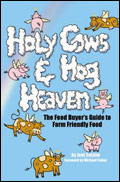Over the past 20 years, Joel Salatin has emerged as a sort of guru of the sustainable-food movement. His 500-acre Polyface Farm in Swoope, Va., is legendary among a small circle of foodies for its robustly flavored beef, pork, chicken, and eggs. Among farmers, Salatin has won cult status for his innovations in multi-species, pasture-based animal husbandry. But readers of his new book, Holy Cows & Hog Heaven: The Food Buyer’s Guide to Farm Friendly Food, won’t be quite as impressed.

Good moos.
Photo: iStockphoto.
Styled as a how-to guide for consumers, the book strives to “inform you, the food buyer, about the farmer’s world and your responsibility in it.” If Salatin is a brilliant farmer, he can be a maddeningly clunky writer. Corny jokes and blanket statements lace his prose. At just 126 pages, the book feels padded; a line of white space separates each paragraph.
Yet Salatin is doing important work, and amid the often-loose verbiage of Holy Cows are ideas that demand attention. The consumer’s first responsibility, for Salatin, is to figure out which farmers are growing with passion, with a love of their land and their product. He implores consumers to get to know the farmers who produce their food. Beautiful food, he implies, is grown in a beautiful place.
“Every day is not picture perfect,” he writes. “But do you get an overall impression of order, effort, happiness, and health? … A farmer is a landscape sculptor. How does his landscape look compared to what is across the boundary fence? In any given season, this will be one of the most dramatic signals of true stewardship.”
Here’s my favorite bit of advice: “Look at [the farmer’s] bookshelves … I am much more interested in a farmer’s books than whether he is certified organic. Anyone can adopt a set of lingo to join the latest marketing fad, but a farmer who truly seeks a different approach will immerse himself in literature on that topic.”
Salatin doesn’t discuss his own “different approach” much in Holy Cows, but Michael Pollan delivered an apt description of it in an issue of Gourmet in 2002: “[I]f you ask Salatin what he does for a living, he’ll tell you he’s a ‘grass farmer.’ That’s because healthy grass is the key to everything that happens at Polyface, where a half-dozen animal species are raised together in a kind of concentrated ecological dance on the theme of symbiosis. Salatin is the choreographer, and these 100 acres of springy Shenandoah Valley pasture comprise his verdant stage.”

Holy Cows & Hog Heaven:
The Food Buyer’s Guide
to Farm Friendly Food
by Joel Salatin, Polyface,
126 pgs., 2005.
Environmentalists take note. Salatin is using his land to transform grass — which humans can’t metabolize — into high-quality protein. Feedlot beef production, which leans on petrochemical-intensive corn for fodder, requires 35 calories of fossil fuel to create one calorie of food. Salatin’s system burns a fraction of that.
Food-lovers take note, too. Polyface produces, in Pollan’s words, “succulent grass-fed beef, ‘chickenier’ chicken, and the super-rich eggs to which pastry chefs attribute quasi-magical properties.”
In one of the few sections of Holy Cows that does describe the goings-on at Polyface, Salatin delivers an example of how his system works. He unleashes portable chicken yards — known among small-scale farmers as “chicken tractors” — on fields after cows have finished grazing there. The chickens peck at the remaining grass, sterilize the cow manure of worms, and leave their own manure behind. All of this prepares the pasture for the next planting of grass — without a bit of off-farm fertilizer.
Holy Cows would be a stronger book if it focused more on Polyface’s elegant system. Most readers who will be drawn to it are already convinced about the merits of buying local, and might be more interested in the feats of low-tech engineering that a gifted farmer like Salatin performs as a matter of course. Humanity’s survival may well hinge more on smartly crafted chicken tractors than on the latest climate-controlled, gas-hog combine from John Deere.
What we get, though, is a kind of grab bag: some of it buy-local boilerplate, some of it valuable, and some of it borderline offensive. More than once, Salatin informs us that he’s a “Christian libertarian environmentalist capitalist.” In a pretty good chapter denouncing genetically modified food, which contains a sophisticated critique of the “objectivity” of science, Salatin argues unedifyingly that GMOs “violate God’s Genesis plan.” Elsewhere, he gratuitously lashes out at abortion doctors.
But his libertarian strain leads to insights worth heeding. The last two chapters rail against the environmental regulations that animal farms operate under — regulations that make sense for, say, a 6,000-cow feedlot operation, but are utterly absurd for a midsized farm like Polyface. Salatin shows that regulations designed to rein in industrial farms often wind up bolstering their power by burdening smaller, environmentally friendly operators with ruinous and unnecessary costs.
He also casts a wary eye at the USDA’s organic-certification program, which he sees as a weak substitute for the hard and rewarding work, as a consumer, of visiting local farms and using one’s own eyes to see what’s happening there. “It deeply saddens me to go into the average health food store and note that 95 percent of what is on the shelves comes from just as far away, and often is picked and processed by the same unjust labor pool, as the Wal-Mart counterparts,” he writes. “Are organic Twinkies really what we’re after?”
Salatin is after something quite different. He wants to restore the sensual basis of food production and consumption in a society that largely accepts flavorless food grown on aggressively ugly farms, under ugly labor conditions. In doing so, he seeks to heal the environmental and social calamities we cause in the process of feeding ourselves.


